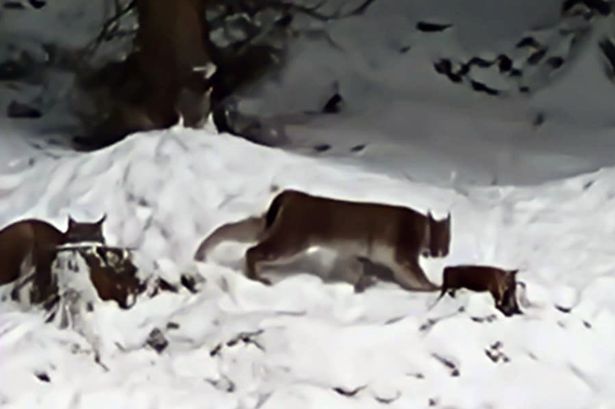The recent sightings of two more Eurasian lynx roaming free in the Scottish Highlands have heightened public concern and sparked renewed efforts to locate and contain these elusive predators. This latest development follows closely on the heels of the successful capture of another pair of lynx in the same region just days prior, underscoring a growing awareness of the presence of these non-native felines in the area. Authorities have issued warnings to the public, emphasizing the importance of avoiding direct contact with the animals and immediately reporting any sightings to ensure both public safety and the successful recapture of the lynx. The situation raises questions about the origin of these animals and the potential impact of their presence on the local ecosystem.
The Eurasian lynx, typically found in the forests of continental Europe and Asia, is not native to the British Isles. Their presence in Scotland suggests either intentional release or escape from captivity, possibilities currently under investigation by relevant authorities. Lynx are apex predators, occupying the top tier of the food chain in their natural habitats. Their diet primarily consists of smaller mammals such as rabbits, hares, and rodents, but they are also capable of preying on larger animals like deer, particularly young or weakened individuals. The introduction of such a predator into an ecosystem unfamiliar with its presence can have significant consequences, impacting existing predator-prey dynamics and potentially influencing the populations of native species.
The concern regarding the impact of these non-native lynx on the Highland ecosystem stems from the potential disruption they could cause to the delicate balance of the existing food web. The sudden introduction of a new apex predator can exert pressure on prey species populations, potentially leading to declines if the prey animals are unable to adapt quickly enough. This, in turn, can have cascading effects on other species within the ecosystem, impacting both predators and prey animals further down the food chain. Furthermore, competition for resources with native predators, such as foxes and wildcats, could further exacerbate the situation, leading to displacement or even localized extinctions of these native species.
Beyond the ecological implications, the presence of free-roaming lynx also raises concerns for public safety. While lynx are generally shy and avoid human contact, they are still wild animals capable of inflicting injury if they feel threatened or cornered. The authorities’ warnings to avoid approaching the animals are a crucial safety measure to prevent any potential human-wildlife conflict. Maintaining a safe distance and reporting sightings promptly allows trained professionals to handle the situation appropriately, minimizing risks to both the public and the lynx themselves. Educating the public about lynx behavior and appropriate responses to encounters is essential for fostering coexistence and ensuring the safety of both humans and these elusive predators.
The ongoing efforts to locate and recapture the lynx involve a combination of tracking techniques, including utilizing trained dogs specialized in scent detection and deploying camera traps in strategic locations to monitor their movements. The rugged terrain of the Highlands presents a challenge for these operations, requiring specialized equipment and expertise to navigate the dense forests and mountainous areas. Collaboration between various agencies, including local wildlife organizations, police, and expert trackers, is crucial for the successful capture and safe relocation of the lynx. The goal is to remove the animals from the wild and place them in appropriate captivity, ensuring their welfare while also mitigating the potential risks they pose to the local ecosystem and public safety.
The situation with the escaped lynx in the Highlands underscores the broader issue of non-native species and their potential impact on established ecosystems. The accidental or deliberate release of non-native animals can have unintended and often detrimental consequences for the environment, local biodiversity, and even human populations. Stricter regulations and enforcement regarding the keeping and transportation of exotic animals are essential for preventing such incidents in the future. Increased public awareness about the potential risks associated with non-native species and the importance of responsible pet ownership can further contribute to protecting the delicate balance of our ecosystems and preventing similar situations from unfolding in the future. The focus now remains on safely capturing the remaining lynx and addressing the underlying issues that led to their release into the wild.














